Mastering Mold Removal: Effective Strategies for Drywall
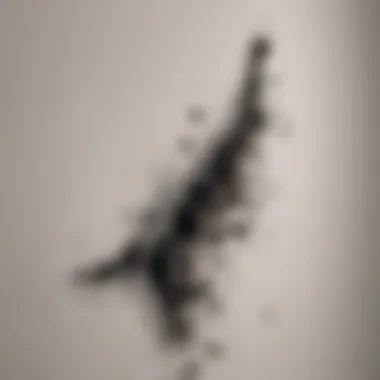
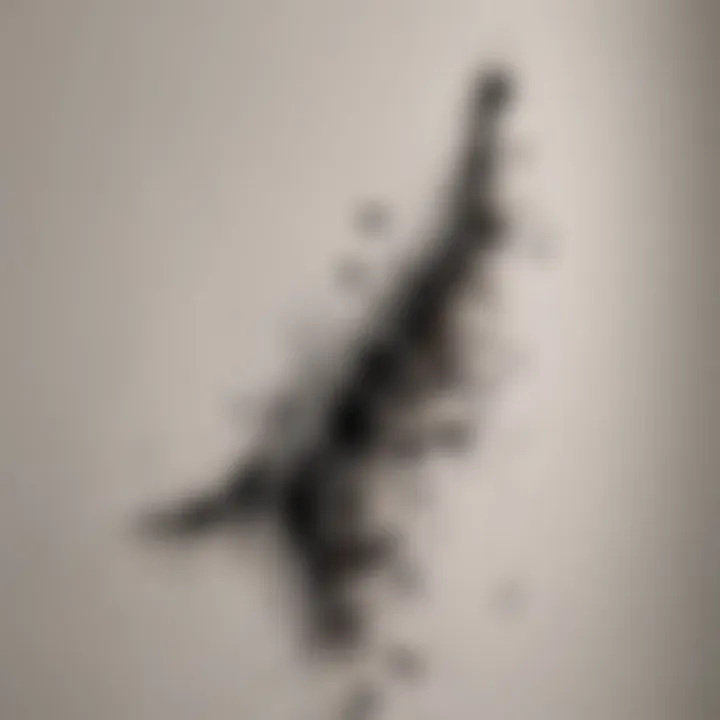
Intro
The sight of black mold on drywall is an alarming indication of moisture problems within a home. Mold not only diminishes the visual appeal of walls but also poses serious health risks to residents. It is crucial for homeowners to understand how to effectively address mold issues. This article will delve into various methods for removing black mold, exploring materials, safety protocols, and preventative measures to ensure a clean environment.
Understanding Mold Behavior
Before tackling mold removal, it is essential to understand how mold grows and why it becomes a problem in homes. Mold thrives in damp, warm environments. The presence of moisture from leaks or high humidity is often what leads to its growth on drywall. Identifying these moisture sources is the first step in effective mold remediation.
Homeowners should look for signs of leaks, condensation, or extreme humidity levels that may contribute to mold growth. This proactive approach enables more efficient future maintenance objectives.
Essential Materials for Removal
To successfully remove black mold from drywall, gather the following materials:
- Cleaning solution: Use a commercial mold removal product or a mixture of water and diluted household bleach. Always follow label instructions.
- Protective gear: Gloves, goggles, and masks are essential to protect against mold spores.
- Scrubbing tools: Stiff-bristle brushes and sponges will help to scrub the affected areas effectively.
- Sealant: After cleaning, applying a sealant or primer can help protect the surface from future mold growth.
Step-by-Step Cleaning Process
- Prepare the area: Ensure the room is well-ventilated. Close doors and windows to avoid spreading mold spores to other areas of the house.
- Wear protective gear: Always put on gloves and a mask to safeguard against mold exposure.
- Apply the cleaning solution: Generously spray the affected drywall with your chosen cleaning solution, ensuring it permeates the mold.
- Scrub the area: Using a stiff-bristle brush, scrub the affected area gently to lift the mold from the surface. Avoid excessive scrubbing, as this could damage the drywall.
- Rinse and dry: Wipe the area with clean water and allow it to dry thoroughly. Ensure the area is completely dry to prevent re-growth.
- Monitor the situation: Keep an eye on the cleaned areas regularly to ensure no return of mold.
"Regular monitoring for moisture and mold is essential to maintain a healthy living environment."
Safety Measures
Ensure safety precautions are taken during and after mold removal:
- Avoid using bleach on porous surfaces like drywall, as it may not eliminate all mold spores.
- Do not mix cleaning agents, especially bleach and ammonia, as toxic fumes can be produced.
- Ensure proper ventilation during the cleaning process.
Preventative Strategies
After successfully removing black mold, preventing its return is crucial. Here are practical steps to minimize the risk of mold recurrence:
- Control humidity: Keep indoor humidity below 60%. Use dehumidifiers where necessary.
- Fix leaks promptly: Address any plumbing issues or roof leaks right away to prevent moisture buildup.
- Maintain good ventilation: Use exhaust fans in bathrooms and kitchens to reduce moisture.
- Inspect regularly: Conduct routine inspections of areas prone to mold, such as basements and bathrooms.
Understanding the proper methods for removing black mold from drywall is essential for any homeowner. By using the right materials, following carefully established procedures, and implementing preventative measures, one can safeguard their home against the health risks associated with mold.
Understanding Black Mold
Understanding black mold is crucial for homeowners and those involved in interior design. Mold is not just an aesthetic issue; it has profound implications for health and property value. Black mold, specifically, thrives in damp environments and can quickly spread if not addressed promptly. Awareness of what black mold is, the potential health risks it poses, and how to identify it effectively sets the groundwork for strategic removal. This understanding emphasizes the need for both preventive measures and appropriate action when it appears.
Defining Black Mold
Black mold, scientifically known as Stachybotrys chartarum, is a type of fungus. It appears as dark green or black patches and is often found in moisture-prone areas such as basements and bathrooms. A typical condition for its growth includes high humidity and stagnant water, which are often a result of leaks or poor ventilation. Recognizing the characteristics of black mold is essential. It typically has a musty odor and may appear fuzzy or slimy, distinct from other mold types. Defining the nature of black mold fosters a more informed approach to its prevention and removal.
Health Risks Associated with Black Mold
The implications of black mold extend beyond aesthetics. Exposure can lead to serious health issues, which is why understanding these risks is imperative. Symptoms may include respiratory problems, allergic reactions, and in severe cases, neurological issues. Individuals with pre-existing conditions, such as asthma or compromised immune systems, are particularly susceptible. Children and the elderly are also at higher risk. Being aware of these potential health impacts underscores the urgency of addressing mold infestations quickly and effectively.
Identifying Mold Infestation
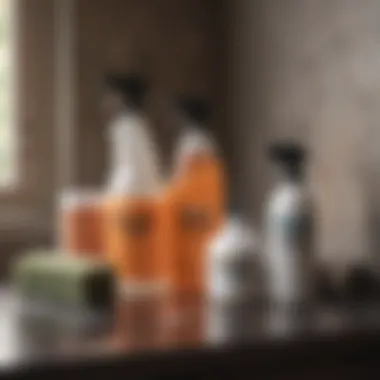
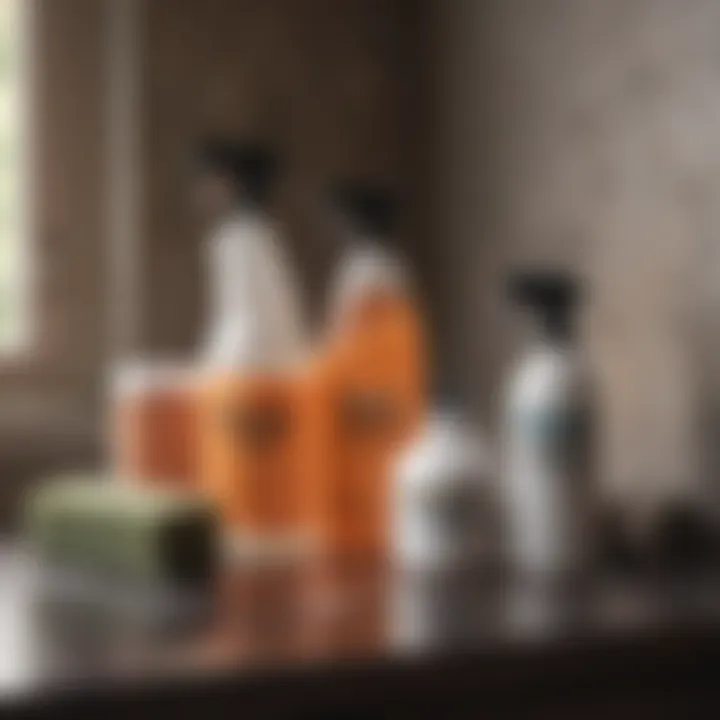
Identifying a mold infestation is key to managing the problem before it escalates. A visual inspection can often reveal signs of mold growth, especially in areas known for moisture. Homeowners should look for discoloration on walls and ceilings, although not all mold is visible. Prolonged dampness or water stains are red flags that should be investigated further. It is also wise to monitor any unusual odors, which may indicate hidden mold behind walls or in insulation. Using tools such as moisture meters can assist in determining humidity levels, helping to catch mold before it becomes a significant issue.
"Timely intervention can save a lot of trouble down the line. Understanding black mold is the first step towards protecting your home and health."
By grasping the essence of black mold, homeowners can take proactive steps toward effective removal and prevention, improving the quality of their living space.
Assessing Damage to Drywall
Assessing damage to drywall effectively is imperative when dealing with black mold. Ignoring the extent of damage can lead to significant health hazards and structural issues in your home. Knowing how to evaluate the severity of the infestation and deciding whether to repair or replace damaged drywall are crucial steps. The right assessment ensures the safety of the occupants and determines the most efficient cleaning methods.
Evaluating Severity of Infestation
To properly evaluate the severity of the black mold infestation, several factors must be considered. The first aspect is the size of the affected area. A small patch might suggest a minor issue, but it could also be a sign of a larger problem lurking behind the walls.
- Measure the Size: If the mold covers an area less than ten square feet, it may be feasible to handle the cleanup yourself. Larger infestations often indicate a need for professional help.
- Check for Spread: Look for signs of mold beyond the visible areas. This includes checking nearby surfaces and even adjacent rooms. Mold spores can easily migrate, creating hidden risks.
- Identify Source: Understanding the source of moisture is essential. Mold thrives in damp conditions. If the cause isn’t addressed, the infestation is likely to recur.
- Material Condition: The condition of the drywall itself should be assessed. Discoloration, bulging, or crumbling indicate severe damage. If the integrity of the drywall is compromised, removal may be necessary.
Determining Repair vs. Removal
Deciding between repairing and fully removing drywall affected by black mold is crucial. This decision often hinges on the evaluation outcomes.
- Extent of Damage: For minor cases where mold is superficial, repair methods like cleaning and sealing can work. In this situation, the damaged area can be removed and replaced with new material.
- Health Risks: Persistent mold on drywall poses health risks, like respiratory issues for residents. If mold penetrates deeply into the materials, replacement may be the only safe choice.
- Cost Considerations: Weigh the cost of repair against full removal and replacement. While repairs may seem cost-effective, failing to address the underlying issue could lead to greater expenses in the long run.
- Professional Insight: Sometimes, consulting an expert is the best course of action. A certified mold remediation specialist can provide insights that enable better decision-making.
In summary, a comprehensive assessment of damage helps ensure the best strategy for addressing black mold on drywall. Determining the severity and deciding on repair or replacement is paramount to maintaining a safe living environment and preventing future issues.
Necessary Tools and Materials
Having the right tools and materials is crucial when dealing with black mold removal on drywall. Using appropriate equipment ensures effectiveness in cleaning and minimizes health risks during the process. Homeowners should take the time to gather the necessary items before starting the cleaning. This preparation makes the effort more efficient and reduces the chances of mishaps during the process.
List of Cleaning Supplies
Here are some essential supplies that one should consider:
- Mold Removal Solution: This can be a commercial mold remover or a mixture of water and vinegar. Both options are effective, but commercial products are often stronger against stubborn mold.
- Spray Bottles: These are helpful for applying mold removal solutions precisely and evenly.
- Microfiber Cloths: They are perfect for wiping down surfaces without adding to the debris. They trap mold spores effectively.
- Scrub Brushes: A stiff-bristle brush can assist in scrubbing the mold off the drywall. Choose one that is not overly abrasive to avoid damaging the surface.
- Buckets: Useful for mixing solutions and rinsing tools.
- Natural Disinfectant: Options like tea tree oil and hydrogen peroxide are safe and help kill mold spores.
The importance of each of these cleaning supplies cannot be overstated. They work together to ensure a clean, mold-free environment is created, reducing the risk of future infestations.
Protective Gear Recommendations
Safety is paramount when cleaning black mold. Here are a few protective gear items:
- N95 Respirator Mask: This mask filters out mold spores from inhaled air. Proper fitting is essential for it to be effective.
- Goggles: Protecting the eyes from mold spores and the cleaning solution is necessary. This will prevent irritation and infection.
- Gloves: Disposable latex or rubber gloves shield the skin from harmful substances. Choosing gloves that fit well increases comfort and effectiveness during cleaning.
- Protective Clothing: Wearing long sleeves and pants decreases the chance of skin contact with mold or cleaning agents.
Remember: Always prioritize safety to ensure an effective cleaning process.
In summary, having the right tools and protective gear prepares homeowners for the effective removal of black mold from drywall. This preparation is essential to create a healthy living environment.
Step-by-Step Cleaning Process
The step-by-step cleaning process is crucial when dealing with black mold on drywall. This procedure not only ensures that mold is effectively removed but also safeguards the health of individuals in the area. A systematic approach minimizes the risk of spreading spores and helps identify any potential damage to the drywall. Furthermore, understanding this process facilitates proper use of cleaning materials and techniques, increasing the likelihood of successful mold eradication.
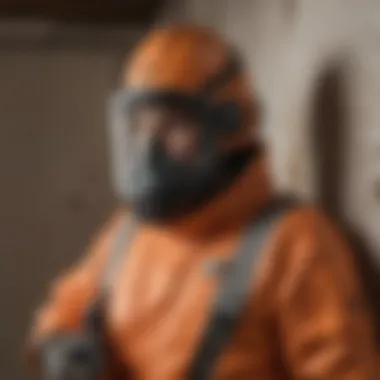
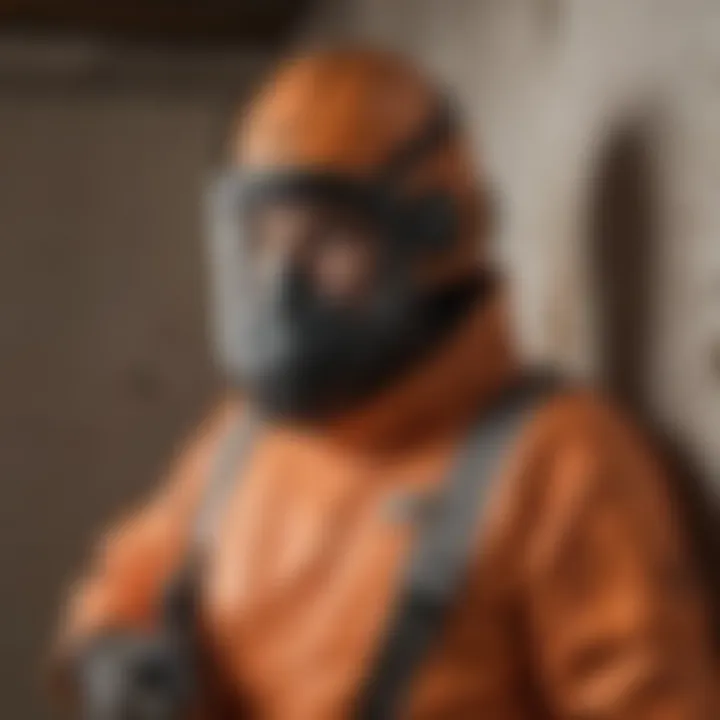
Preparation of the Area
Before initiating any cleaning, preparation is essential. Begin by removing furniture and personal items from the vicinity. This helps in protecting belongs and provides a clear working space. Next, assess the area for any moisture sources. Fix leaks or eliminate standing water, as this reduces the chances of mold recurrence. It is also vital to seal off the area with plastic sheeting to prevent spores from escaping into the air. This creates a contained environment and protects other areas of the home.
- Remove all items from the affected area.
- Fix moisture sources, like leaks.
- Seal the area with plastic sheeting.
- Ensure proper ventilation is in place.
Applying Cleaning Solutions
Once the area is prepared, it's time to apply cleaning solutions. There are various options available, such as commercial mold removers and homemade solutions like vinegar or baking soda. Choose a solution that is suitable for drywall; some products may bleach or damage the surface. Apply the cleaner generously using a spray bottle or sponge.
- Avoid saturating the drywall. Excess moisture can cause more damage.
- Allow the solution to sit for the recommended time to effectively kill the mold spores.
- Consider wearing a mask and goggles during this phase to prevent inhalation of spores or contact with the cleaning solution.
Scrubbing and Removing Mold
After the solution has had time to act, begin scrubbing the affected area. Use a non-abrasive cloth or brush to gently scrub the drywall. The goal is to eliminate visible mold without damaging the surface. If the mold is extensive or deeply embedded, a more thorough approach may be necessary. Understand that some drywall may need to be replaced if the mold has penetrated significantly.
- Use a circular motion to lift the mold from the surface.
- Be cautious near edges and joints where mold tends to grow.
- Deeply embedded areas may require additional applications of cleaning solution.
Rinsing and Drying
The final step in this thorough cleaning process is rinsing and drying the area. Using a clean damp cloth, remove any leftover cleaning solution. It's essential to ensure that all cleaning agents are cleared well to prevent residues that could attract new molds.
Next, allow the area to dry completely. You can employ fans or dehumidifiers to expedite this process. Moisture is a major breeding ground for molds, and ensuring the space is completely dry will aid in combating future growth.
Important: Ensure the area stays ventilated throughout this process. Poor ventilation can lead to stagnant air, which may foster conditions favorable for mold regrowth.
Safety Protocols During Cleaning
Cleaning black mold from drywall requires attention to safety protocols. Mold spores can become airborne, which may lead to health complications. Implementing safety measures protects the cleaner and the household. By recognizing the potential hazards, individuals can avoid respiratory issues and skin irritations caused by mold exposure.
Ventilation Techniques
One vital aspect of ensuring safety during the mold removal process is proper ventilation. Opening windows and doors allows fresh air to circulate through the area. This tactic helps to dilute the concentration of mold spores in the air.
Using fans can enhance airflow, but they should be positioned to blow air out of the space. This causes any particles to move outside instead of spreading within the home. If possible, utilizing an air purifier with a HEPA filter can capture fine particles, further improving air quality. In situations where natural ventilation is limited, wearing a respirator mask is vital. This step adds another layer of protection against inhaling harmful spores.
Disposing of Contaminated Materials
After cleaning, proper disposal of contaminated materials is necessary. Items such as drywall, insulation, or fabrics that have mold growth should be handled with care. They can release spores during removal, so wearing gloves and a mask is crucial.
When disposing of these materials, seal them in plastic bags before leaving the area. This action reduces the risk of spores escaping and contaminating other parts of the home. It is advisable to check local guidelines for disposing of hazardous waste, as improper disposal can lead to further issues.
Overall, employing these safety protocols significantly reduces risks associated with mold cleaning. Prioritizing ventilation and proper disposal ensures not only cleaner living spaces but also protects the health of everyone involved.
Post-Cleaning Restoration
Post-cleaning restoration is a critical phase in dealing with black mold on drywall. This important step serves to address any remaining damage and restore the area to its former condition. Ignoring this phase can lead to further issues down the line, such as mold regrowth or structural damage. To effectively prevent these concerns, assessing the remaining damage and making necessary repairs is essential.
Assessing Remaining Damage
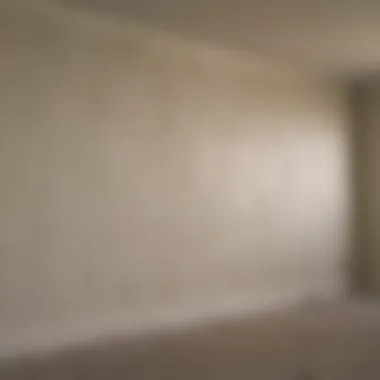
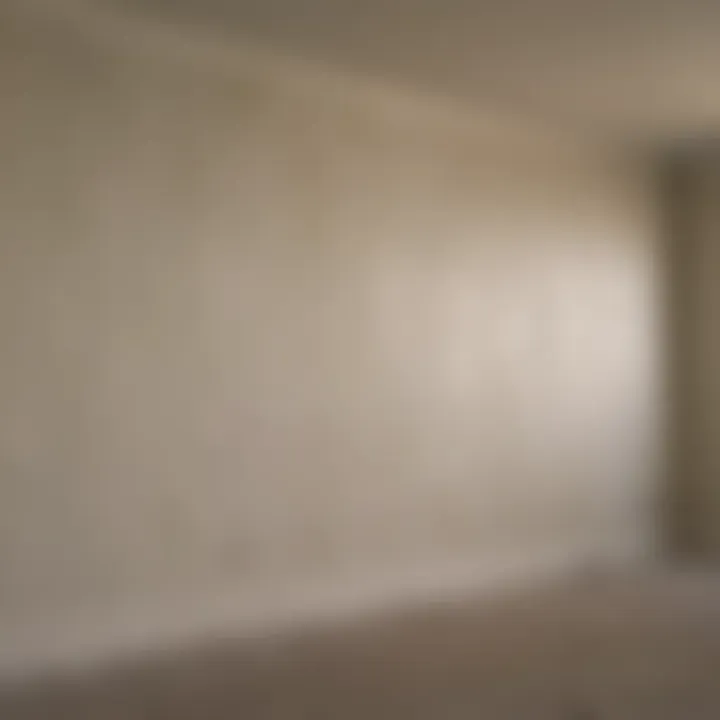
Assessing the damage after cleaning is a vital part of the restoration process. It involves a thorough inspection of the drywall and surrounding areas. First, check for signs of lingering moisture, which is a potential breeding ground for mold. Pay close attention to any discoloration, warping, or sagging that may indicate more significant structural issues.
During this process, consider using a moisture meter to measure the humidity levels in the drywall. If levels remain high, further drying might be necessary.
Additionally, it's wise to document any findings. Take photographs and make notes of areas that still show problems. This documentation can help if you decide to consult a professional later or if you need to refer back in the future.
Repainting and Finishing Touches
Once all damage has been assessed and addressed, repainting and finishing touches can begin. Before repaining, ensure that all areas are completely dry and clean. Any residual cleaning solution or moisture can lead to peel or discoloration over time.
When selecting paint, consider using a mold-resistant primer and paint. These products are designed to deter future mold growth, providing an extra layer of protection. Applying a primer will also enhance the adherence of the top coat, resulting in a smoother finish.
After applying primer, follow with a high-quality paint suitable for interior use. Two coats may be necessary for full coverage and uniformity.
"Proper restoration is not just about appearance; it's about ensuring a durable, healthy environment in your home."
Finally, inspect for any additional touches needed to complete the area. This may include touch-ups around edges, replacing damaged moldings, or reinstalling outlets and switches that were removed during cleaning.
Following these steps ensures a thorough restoration while minimizing the chances of mold returning. Engaging in this detailed approach to post-cleaning restoration reinforces a healthier, safer living space.
Preventative Measures Against Mold Growth
The persistence of black mold presents a challenge for homeowners. These preventative measures not only protect the integrity of the home but also contribute significantly to the health of its inhabitants. Effective prevention requires a multifaceted approach that encompasses controlling moisture, ensuring regular upkeep, and maintaining an awareness of potential mold triggers. Implementing these strategies can save homeowners from costly mold remediation and the health risks that come with mold exposure.
Controlling Humidity Levels
Humidity is a primary factor that helps mold thrive. Keeping humidity levels low should be a priority for maintaining a mold-free environment. Ideal indoor humidity levels are typically between 30% and 50%. Here are effective strategies to control humidity:
- Use Dehumidifiers: These devices are particularly effective in areas prone to dampness, such as basements. They help to lower humidity levels effectively, especially during humid seasons.
- Ventilation: Increase air flow in the home. Open windows when weather permits and use exhaust fans in kitchens and bathrooms to eliminate moisture.
- Insulate Pipes: Cold surfaces may cause condensation. Insulating pipes can prevent water buildup that leads to mold growth.
- Monitor Indoor Plants: While plants improve air quality, over-watering them can lead to excessive moisture. Ensure proper drainage and avoid misting leaves unless absolutely necessary.
Regular Maintenance and Inspections
Routine inspections and maintenance play a crucial role in mold prevention. A vigilant homeowner can catch moisture issues before they escalate. Here are some focused actions to consider:
- Inspections: Conducting monthly inspections, especially in high-risk areas like attics, basements, and around windows can help identify any signs of mold or moisture buildup.
- Repair Leaks Promptly: Addressing leaks in roofs, walls, or plumbing right away can prevent water accumulation, which creates a mold-friendly environment.
- Clean Gutters: Ensure that gutters are not clogged to allow for proper drainage away from the home. Failure to do so can result in water that seeps into walls and ceilings.
- Check Air Conditioning and Heating Systems: Regularly clean or replace filters, and make sure ducts are free from condensation.
By focusing on humidity control and regular maintenance, homeowners can greatly reduce their chances of encountering a black mold problem. Investing time and resources in these preventative measures is a wise choice, fostering a healthier living space for all.
When to Seek Professional Assistance
Understanding when to seek professional assistance in dealing with black mold is crucial. While some infestations can be managed by homeowners, others pose significant risks and may require expert intervention. Recognizing the signs of a substantial infestation and knowing the limits of your capabilities can protect not just your home but also your health.
Identifying Large-Scale Infestations
Large-scale infestations of black mold are often complicated and hazardous. If the mold covers an area greater than ten square feet, it may be a signal to call professionals. Extensive mold growth can be indicative of underlying moisture issues or structural damage that need specialized attention. Homeowners should look for:
- Visible Mold Growth: Black mold can appear as dark patches or spots on drywall. If you see large areas affected, do not underestimate the situation.
- Water Damage Signs: Stains, bubble formations, or moisture in the walls can indicate a bigger problem. Addressing water damage should go hand-in-hand with mold remediation.
- Health Symptoms: If you or your family members experience respiratory issues, headaches, or other unexplained health problems, it might be a sign that mold levels are beyond what is manageable.
When these signs emerge, engaging a mold remediation expert is crucial. They can provide a thorough assessment and a strategic plan to remove the mold and address the source of moisture effectively.
Finding Certified Mold Remediation Experts
Finding a certified mold remediation expert is essential for effective and safe mold removal. Homeowners should consider several factors when selecting a professional:
- Certification: Look for certifications from recognized organizations such as the Institute of Inspection, Cleaning, and Restoration Certification (IICRC). This ensures the expert has undergone rigorous training and understands mold remediation standards.
- Experience: An expert with several years of experience will likely handle complex cases more effectively. Request references or case studies to gauge their previous success.
- Insurance and Warranty: Ensure that the remediation service is insured. A credible service will often provide warranties or guarantees for their work, offering peace of mind in case of recurrence.
- Comprehensive Assessments: A qualified expert should provide a thorough inspection. They should discuss the extent of the infestation and explain the steps involved in remediation.
- Transparent Pricing: Clear and upfront cost estimates can help in understanding the financial commitment before any work begins.
When the complexity of a mold infestation exceeds your comfort level or knowledge, always prioritize safety first and bring in professionals equipped to handle such situations effectively.



